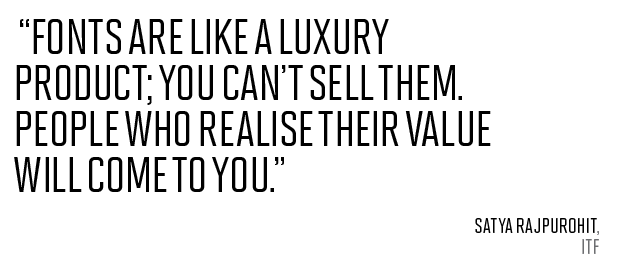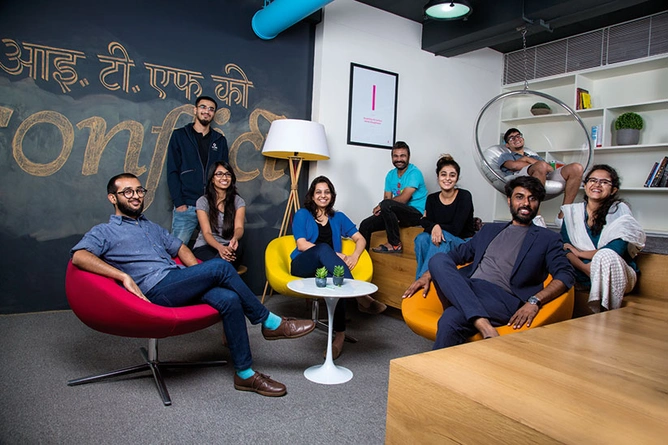There’s a little bit of India in every Apple device, and I’m talking with the man responsible. Unassuming, almost shy about his success, Satya Rajpurohit is in his minimalist office-cum-studio in Ahmedabad, from where he runs India’s first type foundry. Set up in 2009, Indian Type Foundry (ITF) does exactly what it says: it designs fonts. It sounds like an extremely niche business, until you think of this: Fonts are in everything you read, whether on a page or on a screen or on a packet of tea or a bottle of wine.
What’s that got to do with Apple, you may well ask. Two words: system fonts. These are fonts that come installed in a device, and almost always include dozens of languages other than English. And in February 2014, Rajpurohit received an e-mail from Peter Lofting, known to most as the Font Guy at Apple, who said Apple wanted to licence two ITF font families. “This was Apple wanting to license our fonts to use as system fonts,” says Rajpurohit, a trifle breathless about this even three years later. “This was big.” It is a big deal; basically, every time a user switches to an Indian language on an Apple device, that’s Rajpurohit’s work.
Till the Apple project came along, ITF was chugging along. Yes, it had lasted five years without a deal of this size, but Rajpurohit admits there were times he wondered if he should expand the scope of the company to include other elements of graphic design. “I had often asked myself if this narrow focus on type design would be a good idea. Apple settled all those doubts.”

For Rajpurohit, this was the project that turned him into an entrepreneur from a designer.
He had started ITF in 2009 when he was still a student at the National Institute of Design (NID), Ahmedabad. A few years earlier, he had met Peter Bilak, a Slovak type designer, at a design fair, and the two had worked on some projects together. ITF was a collaboration between the two; Bilak handled the business, while Rajpurohit devoted himself to design. But in 2012, with ITF on its second big project with Sony Entertainment, Bilak decided to leave the company. “I had no clue how to even talk to clients, how to structure a project, or negotiate, because Peter handled all of that. There was suddenly a lot on my plate after he left and I had to learn fast,” says Rajpurohit.
Disruption seems to follow Rajpurohit. The eldest son of a businessman, he grew up in Nagaur, a small town in Rajasthan. He was always interested in fine arts, but his parents, like most parents, wanted their son to become a doctor. He was packed off to Kota, a town notorious for its coaching class industry, and was enrolled in a class intended to help him pass the medical entrance exams. The classes didn’t do the trick and Rajpurohit failed the exam. His father insisted that he try again. “Those two years were the worst of my life. I hated every day I spent there,” he says.
Along with a friend who was in the same predicament, Rajpurohit began applying to colleges of art across the country, hoping all the time to enter NID. He didn’t get into NID, and despite vehement opposition from his father, joined Government College of Art, Chandigarh. “I suddenly found myself with people I could relate to, which only encouraged me to apply again to NID, which I did and got through the next year,” says Rajpurohit.
Having got into NID, he tried his hand at animation, then motion graphics, and eventually, graphic design. Type design was not something he had given much thought to. With a mandatory internship coming up in his third year, Rajpurohit scouted around for a likely company and managed to bag a type design project at Linotype in Germany. That was in 2007.
Linotype is globally acclaimed as a premier type foundry, best known perhaps for having Helvetica in its font library. Back in 2007, Linotype was looking for an Indian designer to help create the Devanagari companion for one of its popular fonts, Frutiger, a landmark sans serif font family designed by Adrian Frutiger, one of the most influential typeface designers of the 20th century. “It’s strange how connections get made,” Rajpurohit tells me over lunch at Swati Snacks, a restaurant famous for its traditional Gujarati cuisine. “Did you know Frutiger designed the NID logo?” And then tells me that NID was originally called the National Design Institute. It renamed itself to match Frutiger’s stylised NID logo.

That was the beginning of Rajpurohit’s fascination with type design. Back at Linotype, as his internship was coming to an end, Rajpurohit decided to visit Bilak in the Netherlands. Bilak was impressed by Rajpurohit’s work at Linotype and offered him an assignment: to create the Devanagari version for his font family, Fedra. By 2009, Bilak and Rajpurohit had decided to launch ITF with Fedra Hindi. One of Bilak’s big contributions to ITF’s success was his insistence on creating fonts in Unicode, a computing standard for writing systems across platforms. Simply put, the fonts that ITF created could be easily used in print, television, and websites. “We wanted to focus on building fonts on Unicode, even though there was hardly anyone using Unicode systems in India,” says Rajpurohit. Fedra Hindi was the first Unicode font to be published in India.
Meanwhile, Rajpurohit had begun working on Kohinoor, a new font family for 11 Indian languages. “There’s a difference between the weights and basic shapes of the Devanagari letters and the Latin script. So, in some senses, Fedra Hindi isn’t a true match, because it wasn’t possible to make it so since Fedra was already published and I couldn’t make any changes to that,” says Rajpurohit. What he wanted to do was create a new font family, ground-up, for 11 languages, including English. By the time ITF got its first client in 2010, Star TV, six fonts from the Kohinoor family had been published: Latin, Devanagari, Gurumukhi, Gujarati, Bengali and Tamil.
Kohinoor was one of the fonts Apple wanted to licence, but the company wanted some iterations to the font. “As a font designer, your work is extremely meticulous. But with Apple, we were suddenly working at a whole new level,” says Rajpurohit. He recalls an instance when Apple asked him to alter the angle of a vowel sign in the Devanagari script. “What we had done initially made the letter look heavy and dark; changing the angle gave it a little more space. It was such a minute change, but Apple insisted we get it right.”
Typically, when a client commissions new fonts, it’s a collaborative process with drafts moving back and forth between the design house and the client. But when a company licenses fonts off the shelf, like Apple did, any iteration or customisation is chargeable. When the contract was signed, Rajpurohit was still thinking like a designer. “I thought it was Apple, they would’ve anyway tested the fonts extensively before finalising, so there wouldn’t be too much to change. I couldn’t have been more wrong. We could have designed a few new fonts in the time it took to make those tweaks,” he says.

Would things have been easier had Bilak been around? Undoubtedly. But Rajpurohit would never have become the entrepreneur that he is today. And Apple was a big chapter in that journey. Today, he manages day-to-day operations as well as the larger strategic goals at ITF. He works with a team of eight designers, and a Chinese developer who is familiar with Indic scripts and had interned at ITF. “I wanted to keep the office environment in a creative mode, so it’s just us,” he says, pointing to his team hunched over iMacs, sipping Blue Bottle coffee brewed in a Miele coffee maker. He spent months designing the office, ordering furniture from all over the world. “We worked out of a rented apartment for the first few years of ITF. When we moved here, I wanted to make this a place I love coming to every morning,” he says.
With no salespeople, how does he sell? “I never go out to pitch,” Rajpurohit tells me. “Fonts are like a luxury product; you can’t sell them. People who realise their value will come to you,” he says. Today, ITF counts Apple, Google, Samsung, Starbucks, Amazon, Star, Sony, and the Leela Hotels among its clients and expects to close this financial year with revenues of nearly $2 million (Rs 12.6 crore).
But, he says, he still gets blank looks when he tells people he designs fonts. “They say, that’s great, but what do you do for a living? When I tell them, I can make a decent living out of it, they ask: But who buys fonts?” They have a point there. Type designers, or even graphic designers in India don’t always have million-dollar top lines, a fact that Rajpurohit is acutely aware of. He says that the upside in his business comes from custom projects; retail sales and licences don’t rake in the big bucks.
Which is why, for the past few months, he’s been working on the blueprint for an online marketplace for fonts. The platform will compete with the likes of MyFonts, the Amazon of the fonts business, owned by Monotype, the world’s largest type design firm. The idea came from his experience of retailing his fonts on MyFonts. “We realised that our Latin fonts did very well on MyFonts, so I thought why not build a platform to sell fonts?” he says. Expected to launch later this year, the store will focus on Latin fonts. “Because I started with Indic languages, somehow we never looked at Latin. But since 2015, we’re trying to build our Latin font library and have over 60 Latin font families today,” he says. (The company has over 150 font families across Latin and Indic languages.)
With the launch of this store, Rajpurohit will have designs to take on the global market. It’s treading new ground. For starters, it will need investment to get it off the ground; it’s not a model Rajpurohit has worked with so far. ITF turned profitable in 2011, almost immediately after it bagged the Star TV project. With this, Rajpurohit will take on Monotype, which incidentally had offered to buy him out a couple of years ago. That could mean sinking in big capital, but Rajpurohit is confident that he’s plugging a gap that MyFonts doesn’t address. He has put in some $3 million in this venture. He doesn’t reveal much else, except that he’s bet everything he’s saved so far, “because I’m confident this will change the industry for good”.










Leave a Comment
Your email address will not be published. Required field are marked*